Astronomy
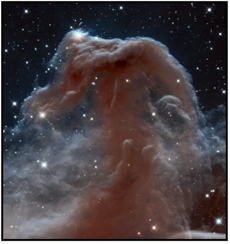 Appalachian astronomers benefit from unique facilities at the Dark Sky Observatory, in addition to using large ground-based observatories like the Keck telescope or the National Optical Astronomy Observatory. Current research efforts focus on stellar spectroscopy, stellar populations, eclipsing binary stars, exoplanet detection, and the chemistry of forming planetary systems. In addition, we study comets at optical and infrared wavelengths through spectroscopy, employing telescopes ranging from our local Dark Sky Observatory all the way to the large facilities such as the Keck telescopes in Hawaii and the James Webb Space Telescope (JWST).
Appalachian astronomers benefit from unique facilities at the Dark Sky Observatory, in addition to using large ground-based observatories like the Keck telescope or the National Optical Astronomy Observatory. Current research efforts focus on stellar spectroscopy, stellar populations, eclipsing binary stars, exoplanet detection, and the chemistry of forming planetary systems. In addition, we study comets at optical and infrared wavelengths through spectroscopy, employing telescopes ranging from our local Dark Sky Observatory all the way to the large facilities such as the Keck telescopes in Hawaii and the James Webb Space Telescope (JWST).
Associated Faculty
Atomic, Molecular and Optical Physics
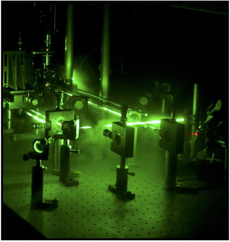 The department includes the Biophysics and Optical Sciences Facility (BiyOSeF) and the Ion Trap Laboratory. Using automated optical tweezers, Raman spectroscopy, fluorescence anisotropy, and a Laser Tweezers Raman Spectroscopy (LTRS) system, faculty at Appalachian explore the properties of microorganisms, proteins, and other biological molecules. Faculty also conduct research on the radiative properties and reaction rates of low-charge-state ions produced and stored in a UHV environment.
The department includes the Biophysics and Optical Sciences Facility (BiyOSeF) and the Ion Trap Laboratory. Using automated optical tweezers, Raman spectroscopy, fluorescence anisotropy, and a Laser Tweezers Raman Spectroscopy (LTRS) system, faculty at Appalachian explore the properties of microorganisms, proteins, and other biological molecules. Faculty also conduct research on the radiative properties and reaction rates of low-charge-state ions produced and stored in a UHV environment.
Associated Faculty
Nanoscience and Condensed Matter Physics
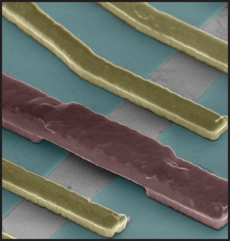 The department includes state of the art microscopy facilities, as well as nanofabrication capabilities ranging from UHV thin-film deposition to e-beam lithography. Faculty use scanning probe microscopy and scanning electron microscopy techniques to explore the properties of organic semiconductor thin films or the growth of metallic nanoparticles. Research at Appalachian also entails the fabrication of two-dimensional van-der-Waals heterostructures and quantum transport in mesoscopic superconducting devices.
The department includes state of the art microscopy facilities, as well as nanofabrication capabilities ranging from UHV thin-film deposition to e-beam lithography. Faculty use scanning probe microscopy and scanning electron microscopy techniques to explore the properties of organic semiconductor thin films or the growth of metallic nanoparticles. Research at Appalachian also entails the fabrication of two-dimensional van-der-Waals heterostructures and quantum transport in mesoscopic superconducting devices.
Associated Faculty
- Patricia Allen, Retired
- Tonya Coffey
Atmospheric and Environmental Science
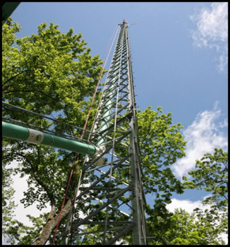 Faculty members are involved in interdisciplinary research initiatives in collaboration with the Environmental Science Program. Facilities include the Appalachian Atmospheric Interdisciplinary Research Program (AppalAIR), an air quality and climate research station which provides data for the Appalachian area. Facilities also include the Applied Fluids Lab (AFL). Projects entail the modeling of granular flow, sediment transport, and river streams, as well as research on air pollution and transport, the impact of aerosols on climate and the forecast of high-impact events (severe weather) in the context of climate variability and change. Additionally, the Ion Trapping Lab conducts work on molecular ions that are abundant in the Ionosphere and active in ozone and IR production in that region.
Faculty members are involved in interdisciplinary research initiatives in collaboration with the Environmental Science Program. Facilities include the Appalachian Atmospheric Interdisciplinary Research Program (AppalAIR), an air quality and climate research station which provides data for the Appalachian area. Facilities also include the Applied Fluids Lab (AFL). Projects entail the modeling of granular flow, sediment transport, and river streams, as well as research on air pollution and transport, the impact of aerosols on climate and the forecast of high-impact events (severe weather) in the context of climate variability and change. Additionally, the Ion Trapping Lab conducts work on molecular ions that are abundant in the Ionosphere and active in ozone and IR production in that region.
Associated Faculty
Robotics and Electronics
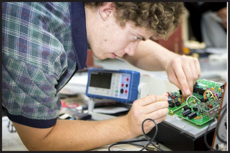 Faculty members are collaborating with NASA to develop instrumentation related to the Artemis moon landing program and Mars rover program. The department is also involved in the development of remote sensing instrumentation (Braille display, stream monitoring, telemetry...), and is a part of Team Sunergy, Appalachian's solar vehicle team.
Faculty members are collaborating with NASA to develop instrumentation related to the Artemis moon landing program and Mars rover program. The department is also involved in the development of remote sensing instrumentation (Braille display, stream monitoring, telemetry...), and is a part of Team Sunergy, Appalachian's solar vehicle team.
Associated Faculty
Additional facilities available to faculty, staff, and students include:
- Astronomy Instrumentation Development Lab
- Applied Fluids Laboratory
- Demonstrations Facilities
- Electronics, Instrumentation, and Robotics Laboratories
- Electronics Tech Shop
- Machine Shop
- Physics Demonstrations and Instructional Facilities
- Rankin "GoTo" Instructional Astronomy Facility